chapter 1 student movement for racial equality - Campus Activism
chapter 1 student movement for racial equality - Campus Activism
chapter 1 student movement for racial equality - Campus Activism
Create successful ePaper yourself
Turn your PDF publications into a flip-book with our unique Google optimized e-Paper software.
CHAPTER 1<br />
STUDENT MOVEMENT FOR RACIAL EQUALITY<br />
Under the tree…blood on the limbs and blood at the roots, black bodies swinging in the<br />
breeze…Bulging eyes and the twisted bowels and then the sudden smell of burning<br />
flesh…Here is a strange and bitter fruit.<br />
-Billie Holliday<br />
THE EARLY STUDENT SIT-INS<br />
In the spring of 1960, black <strong>student</strong>s (and some whites) around the South began a<br />
militant extra-legal struggle <strong>for</strong> <strong>racial</strong> <strong>equality</strong> and justice. Eventually the <strong>student</strong>s were<br />
at the <strong>for</strong>efront of a grassroots <strong>movement</strong> of southern blacks. Although the civil rights<br />
struggle had begun earlier in the 1950's with the NAACP-led legal battles <strong>for</strong><br />
desegregation and the mass action of the Montgomery bus boycott of 1955, the<br />
Greensboro sit-in heralded in a new era which broke dramatically from the past.<br />
"It is hard to overestimate the electrical effect of that first sit-in in Greensboro, as<br />
the news reached the nation on television screens, over radios, in newspapers. In his<br />
Harlem apartment in New York City, Bob Moses, a <strong>for</strong>mer Harvard graduate <strong>student</strong> and<br />
mathematics teacher, saw a picture of the Greensboro sit-inners. 'The <strong>student</strong>s in that<br />
picture had a certain look on their faces,' he later told writer Ben Bagdikian, 'sort of<br />
sullen, angry, determined. Be<strong>for</strong>e, the Negro in the South had always looked on the<br />
defensive, cringing. This time they were taking the initiative. They were kids my age,<br />
and I knew this had something to do with my own life….'" (Zinn, 1965, p. 17). Moses<br />
later became one of the Student Nonviolent Coordinating Committee (SNCC) leaders.<br />
The Greensboro sit-in struck a chord among southern black <strong>student</strong>s. The idea of<br />
nonviolent direct action spread quickly throughout the South, spurring thousands of<br />
<strong>student</strong>s and later others to action. Nashville, Tennessee became one center of sit-in<br />
activity. Nashville <strong>student</strong>s displayed a level of dedication which was to set the tone <strong>for</strong><br />
the <strong>movement</strong>. Those arrested there refused to pay bail, choosing to remain in jail<br />
instead. By this, they denied the legitimacy of the legal system in their struggle. In<br />
February of 1961, the 'jail, no bail' strategy was adopted as SNCC policy.<br />
Marion Barry, a Fisk University graduate <strong>student</strong> and later the first chair of<br />
SNCC, took a leading role in the Nashville sit-ins. "I came to Fisk…inquired about<br />
<strong>for</strong>ming a <strong>chapter</strong> of the NAACP…but we didn't do much…. We had not at any time<br />
thought about direct action. In the meantime in Greensboro, N.C., the <strong>student</strong> <strong>movement</strong><br />
began on February 1, 1960. So we in Nashville decided we wanted to do something<br />
about it…. I remember the first time I was arrested, about February 27…. I took a<br />
chance on losing a scholarship or not receiving my Master's degree. But to me, if I had<br />
received my scholarship and Master's degree, and still was not a free man, I was not a<br />
man at all," said Barry (ibid., p. 19). Not only did the <strong>student</strong>s risk their academic<br />
careers, they braved incarceration and violent reaction to their nonviolent sit-ins. It was<br />
not long be<strong>for</strong>e they had to prepare themselves to sacrifice their blood and even their<br />
lives.<br />
The sit-in <strong>movement</strong> was soon characterized by skillful organization, creative and<br />
sophisticated tactics, and highly principled and disciplined participants. The fundamental<br />
6
nature of the discrimination they were attacking and the level of dedication of the sitinners<br />
earns them the title of social revolutionaries. Though they were unarmed, they<br />
were at war with white supremacy, one of the basic tools used by American business to<br />
divide and rule the workers in this country. Impatient with the slow pace of<br />
desegregation, the legal system, concessions, and traditional black organizations like the<br />
NAACP, they turned to the use of the extraparliamentary tactic of civil disobedience and<br />
were soon quite successful in the upper South and peripheral southern states. By<br />
addressing their grievances illegally and victoriously, they posed an enormous threat to<br />
the American political system, delegitimizing it in the eyes of many of its citizens.<br />
At the April 1960 Raleigh conference, which brought 126 <strong>student</strong> delegates<br />
together, the <strong>student</strong>s decided to remain independent of adult organizations (like the<br />
Southern Christian Leadership Conference and the Congress of Racial Equality) but to<br />
maintain friendly ties. At the conference, a keynote speaker Rev. Martin Luther King, Jr.<br />
articulated the <strong>movement</strong>'s rejection of the NAACP and other "old" black middle-class<br />
groups. King characterized the sit-in <strong>movement</strong> as a "revolt against those Negroes in the<br />
middle class who have indulged themselves in big cars and ranch-style homes rather than<br />
in joining a <strong>movement</strong> <strong>for</strong> freedom," (West, 1984, p. 47).<br />
This desire <strong>for</strong> autonomy distinguishes the <strong>student</strong> <strong>movement</strong> from the 1930's<br />
<strong>movement</strong> and from their white contemporaries of SLID who didn't break from their<br />
parent organization until 1962. This mood has characterized the <strong>student</strong> <strong>movement</strong> in the<br />
U.S. ever since and <strong>for</strong>ms the beginnings of the New Left <strong>movement</strong>.<br />
In the statement of purpose adopted at the Raleigh Conference, the <strong>student</strong>s<br />
declared:<br />
We affirm the philosophical or religious ideal of nonviolence as the<br />
foundation of our purpose, the pre-supposition of our faith, and the<br />
manner of our action. Nonviolence as it grows from Judaic-Christian<br />
traditions seeks a social order of justice permeated by love. Integration of<br />
human endeavor represents the first step towards such a society…. (Cohen<br />
and Hale, 1967, Appendix).<br />
They decided to set up an office, hire a secretary to staff it, print a newsletter<br />
called The Student Voice, raise funds, plan nonviolent training <strong>for</strong> the summer and<br />
coordinate the various activities in the South. Their goals were to end segregation and<br />
discrimination, assure southern blacks of the right to vote, and to seek fair employment<br />
laws among others.<br />
For the most part, the participants in the sit-ins were "not middle class re<strong>for</strong>mers<br />
who became somehow concerned about others. They come themselves from the ranks of<br />
the victims,…[in general] they are young, they are Negro, they come from the South,<br />
their families are poor and of the working class, but they have been to college. Northern<br />
middle class whites and Negroes are a minority," (Zinn, 1965, pp. 9-10).<br />
Black <strong>student</strong>s first began to confront the UT Regents around this time. 4 After<br />
months of discussion, on March 11, 1960 a group of <strong>student</strong>s held the first civil rights<br />
protest conducted by <strong>student</strong>s at UT. They demonstrated on the fringe of the campus<br />
4 Although there had been protests during the 1950's on the UT campus, the participants in these<br />
demonstrations were members of the community demanding that the university be opened to African-<br />
American <strong>student</strong>s.<br />
7
calling <strong>for</strong> university integration. The following day, they wrote a letter in response to a<br />
public statement made by UT President Logan Wilson the previous day. Wilson had<br />
stated that:<br />
In response to queries to [UT] regarding the policy of integration, it should<br />
be pointed out that there is complete integration with reference to all<br />
educational opportunities and facilities… [and] <strong>for</strong>ced integration in social<br />
and extracurricular areas has not yet been established. In view of our<br />
known achievements in meeting what is everywhere a difficult situation, I<br />
am surprised that our institution should be made a target <strong>for</strong> provocative<br />
demonstrations (Daily Texan, March 13, 1960, p. 1 - emphasis added).<br />
The group of less than 50 <strong>student</strong>s picketed a regents meeting which was being held on<br />
the campus that weekend. A group of black women presented a petition to be read at the<br />
meeting. These women wrote:<br />
Be it resolved that we, the undersigned Negro women of the University of<br />
Texas deem the designation of certain specific living units <strong>for</strong> the<br />
exclusive use of Negro women, or the restriction of Negro women to<br />
certain specified dorms a deprivation of our recognized right as University<br />
<strong>student</strong>s to select the living facilities of our choice, (Duren, 1979, p. 7).<br />
The <strong>student</strong> demonstrators also wrote a letter to UT President Logan Wilson<br />
citing housing, sports and public per<strong>for</strong>mance restrictions as areas which needed to be<br />
opened up to blacks. In part the letter read:<br />
We recognize the University of Texas was one of the first universities in<br />
the South to take significant action toward integration with the admission<br />
of Negro undergraduate <strong>student</strong>s in 1956. However, significant advances<br />
in this direction have ceased. Our present concern is <strong>for</strong> a resumption of<br />
this policy of leadership and <strong>for</strong> desegregation in all areas of University<br />
life, (ibid.).<br />
Despite Wilson's earlier derogatory statement about the demonstrators, that<br />
weekend the UT administration decided to convert International House into a dormitory<br />
<strong>for</strong> black women at a cost of $30,000 and to open other dorm space <strong>for</strong> black men. At<br />
this time the administration was only bound by the "separate, but equal" doctrine; it had<br />
no intention of desegregating further. The concession was called "only a token answer to<br />
the urgent question of 'When?'…. A satisfactory answer doesn't seem likely <strong>for</strong> quite a<br />
while. For it is probable that the public relations-conscious university will continue to<br />
move just as slowly as in the past - in spite of the protests of the Negro <strong>student</strong>s who<br />
desire only to be first class <strong>student</strong>s in a University of the First Class," (Daily Texan,<br />
March 13, 1960). The <strong>student</strong> protesters echoed these sentiments when they walked out<br />
of a meeting with UT Vice President Harry Ransom on March 15 after their demands <strong>for</strong><br />
integration of housing, athletics and drama productions were not seriously considered<br />
(Daily Texan, March 15, 1960).<br />
The March protest was the first <strong>student</strong> action since the Rainey incident and<br />
signalled the beginning of the UT <strong>student</strong> <strong>movement</strong> <strong>for</strong> civil rights. It is significant that<br />
the black enrollment at UT was very low at this time and the character of protest was<br />
different at the predominantly white university than it was in other areas of the South<br />
where much of the protest activity was led by <strong>student</strong>s at black colleges. UT <strong>student</strong>s<br />
were, however, quite aware of <strong>student</strong> activities around the South as some UT <strong>student</strong>s<br />
8
went to centers of sit-in activity throughout the early 1960's to support other activists and<br />
to learn from them.<br />
Students from UT and Huston-Tillitson (a predominantly black college in East<br />
Austin) actively sought desegregation in the Austin business community in the late<br />
spring. They began picketing restaurants on the Drag in April and started sitting in at<br />
downtown lunch counters in May. They also sought to integrate Drag theaters, holding<br />
stand-ins and pickets.<br />
That fall, a new <strong>student</strong> group was <strong>for</strong>med which reflected the spirit of SNCC.<br />
The organization was called Students <strong>for</strong> Direct Action and its concern was that<br />
"integration is practically at a standstill in the university area. Most of the <strong>student</strong>s are<br />
not even aware of the segregation tactics employed by the university and by business<br />
firms in the area," according to Chandler Davidson, a leader of the group (Duren, 1979).<br />
The Students <strong>for</strong> Direct Action maintained ties with SNCC, continued with sit-ins and<br />
pressured the university <strong>for</strong> change.<br />
During the fall semester the first violent reaction to the <strong>student</strong> <strong>movement</strong><br />
occurred. White supremacists exploded a bomb in the stairwell of the YMCA while<br />
<strong>student</strong>s involved in desegregation ef<strong>for</strong>ts were holding a meeting in the building.<br />
Fortunately no one was injured and two of the terrorists (who were UT <strong>student</strong>s) were<br />
later charged with involvement in the incident (Duren Papers, Barker Texas History<br />
Center). The <strong>student</strong>s used the University area YMCA as a place to conduct orientation<br />
sessions <strong>for</strong> black <strong>student</strong>s and held their meetings there. 5<br />
The UT <strong>student</strong>s who participated in the civil rights <strong>movement</strong> in 1960 were<br />
primarily motivated by self interest. As in other areas of the South, the participants were<br />
mostly black and poor; they were confronted with physical segregation both at school and<br />
in the community, as well as the reality of <strong>racial</strong> hatred. Their political rhetoric was<br />
rooted in both the American tradition of Judeo-Christian morality and an appeal to<br />
national political symbols (like the Declaration of Independence and the Constitution),<br />
espousing <strong>equality</strong> and freedom.<br />
It was this appeal to traditional moral and political beliefs which attracted the<br />
participation of white middle class <strong>student</strong>s whose self-interest was not so directly<br />
effected by the civil rights <strong>movement</strong>. The participation of these white middle class<br />
<strong>student</strong>s alongside the black <strong>student</strong>s was crucial <strong>for</strong> the civil rights <strong>movement</strong> locally<br />
simply because of demographic differences between Texas and other areas of the South.<br />
While the populations of states like Mississippi and Alabama are around 50% black,<br />
Texas blacks compose about 12% of the state's population. Thus, the ability to mobilize<br />
white and middle class <strong>student</strong>s through the appeal to traditional American beliefs was an<br />
important trait of the local <strong>movement</strong>.<br />
Initial participants in the <strong>student</strong> <strong>movement</strong> <strong>for</strong> <strong>racial</strong> <strong>equality</strong> at UT were few in<br />
number. They were mostly black, poor and very dedicated. They were not only UT<br />
<strong>student</strong>s but also Huston-Tillitson <strong>student</strong>s who participated in the early sit-ins. The<br />
actions during 1960 by this relatively small group of committed activists had earned them<br />
a following of many whites in the university community by Spring of 1961.<br />
5 The 'Y' became the center <strong>for</strong> radical <strong>student</strong> groups later in the 1960's and early 1970's.<br />
9
GROWING MILITANCY AMONG BLACK STUDENTS<br />
As previously mentioned in February 1961, SNCC adopted the "jail, no bail"<br />
strategy as policy. Ten <strong>student</strong>s had been arrested in Rock Hill, South Carolina and<br />
refused bail. SNCC sent four people to join the others <strong>for</strong> the purpose of dramatizing the<br />
injustice. The fourteen young people spent a month in prison. 'Jail, no bail' spread<br />
quickly, first to Atlanta where 80 <strong>student</strong>s from black colleges went to jail. As public<br />
opinion increasingly swung in their favor and more desegregation victories were<br />
achieved, the <strong>student</strong>s became even more militant that summer with their involvement in<br />
the bloody Freedom Rides.<br />
The northern civil rights group CORE organized the first Freedom Ride in May of<br />
1961 to draw attention to the southern failure to en<strong>for</strong>ce a Supreme Court decision to<br />
outlaw segregation in interstate travel. The thirteen Freedom Riders (some of whom<br />
were <strong>student</strong>s) began the bus ride in Washington, D.C. with New Orleans as their<br />
destination. Although they encountered some harassment and a few arrests in the upper<br />
South, their passage through the Deep South (Mississippi and Alabama) proved the<br />
greatest obstacle. In Anniston and Birmingham, Alabama the Riders braved bombs, busburnings<br />
and beatings by white mobs. Police protection was almost nil. They decided to<br />
fly from Birmingham to New Orleans to participate in a mass rally there on May 17.<br />
Students from Nashville and Atlanta refused to accept this victory <strong>for</strong> white<br />
supremacy. Although the <strong>student</strong> Freedom Riders went farther and received more<br />
protection than the first convoy, they too faced violent mobs, this time in Montgomery,<br />
Alabama. While they treated their wounds, they were met by more <strong>student</strong> Riders there<br />
and continued to Jackson, Mississippi where the 27 were arrested. They refused to pay<br />
their fines and spent two months on a penal farm where many of them were beaten.<br />
The adult organization SCLC conceded to the federal government a temporary<br />
lull in the Freedom Rides, but the Attorney General had negotiated with the wrong group.<br />
A pilgrimage of <strong>student</strong>s to Jackson continued throughout the summer. By August, over<br />
300 had been arrested. The guards at the Parchman penitentiary used electric shocks,<br />
"wristbreakers," 6 and other <strong>for</strong>ms of torture on the <strong>student</strong>s, but were unable to break<br />
their spirits. If the <strong>student</strong>s had not remained so strong in their determination, it is<br />
probable that they would not have achieved the victory of September 22, 1961 when the<br />
Interstate Commerce Commission decided to desegregate bus and train stations.<br />
After the Freedom Riders were released from prison in August, SNCC held a<br />
meeting at Highlander Folk School in Tennessee. At the Highlander meeting, the conflict<br />
between those supporting concessions to the political establishment (i.e. to the Kennedy<br />
administration) and those supporting a continuation of the uncompromising tactics of<br />
SNCC. "In the eyes of many SNCC members, the 'Establishment' against which they<br />
were struggling began to encompass both the Democratic Party's liberals and the SCLC's<br />
black activist liberals. This slow rupture would result in some glaring defeats in the civil<br />
rights <strong>movement</strong>, most notably the Albany, Georgia Movement in December 1961, and<br />
also led to the gradual breakaway of SNCC from the techniques of nonviolence," (West,<br />
6 The term "wristbreakers" refers to a long metal tool used by police to more easily pin a person's arm<br />
behind her/his back. They are functional in arresting or quieting an inmate, because they allow increased<br />
leverage and thus application of pain to the victim's wrist and arm. They are sometime used to aid in<br />
police interrogation.<br />
10
1984, p. 48). The <strong>student</strong> factions compromised, deciding to continue the direct action<br />
strategy and also to pursue voter registration of blacks in the Deep South. The activists<br />
then headed south.<br />
Meanwhile at UT, the controversy over segregated university facilities was<br />
heating up. In January 1961, <strong>student</strong>s began picketing the segregated theaters on the<br />
Drag in increasing numbers following scuffles between hecklers and picketers. By<br />
February, the stand-in crowd had grown to over 500 <strong>student</strong>s. Faculty members began to<br />
support the protesters at this time, with 260 signing an Austin American Statesman<br />
advertisement <strong>for</strong> theater integration (Duren, 1979).<br />
Segregated university housing was increasingly opposed by <strong>student</strong>s during the<br />
spring. In May, the regents received petitions from the Student Assembly and the Faculty<br />
in favor of integration of housing and athletics; over 7000 signed the pro-integration<br />
petition. However opposition continued; 1300 <strong>student</strong>s signed a petition opposing the<br />
integration of dorm (ibid.). The majority of <strong>student</strong>s did support integration by this time.<br />
A poll conducted in May 1961 indicated that roughly 60% of the <strong>student</strong>s favored "equal<br />
access to all University-owned facilities," (ibid.).<br />
The Board of Regents ignored the opinions of the faculty and <strong>student</strong>s by<br />
unanimously adopting a policy opposing integration at its July meeting. They issued a<br />
statement saying:<br />
Whether or not we agree with the decisions of the Supreme Court on <strong>racial</strong><br />
integration, we shall in good faith proceed and have hereto<strong>for</strong>e proceeded<br />
along this path with all deliberate speed…. We have a heavy<br />
responsibility to per<strong>for</strong>m, and we respectfully ask you to trust our<br />
judgment. We do not feel that any substantial changes should be made<br />
in the immediate future, but we shall continue to move <strong>for</strong>ward with due<br />
and deliberate speed as we think advisable under all the circumstances<br />
which exist from time to time (ibid. - emphasis added).<br />
This statement reflects the paternalism, arrogance and intransigence on the part of<br />
the regents which has been a characteristic attitude of the body toward social change.<br />
The decision was a slap in the face to the university community and demonstrated the<br />
lack of democracy within the university structure. 7 The fact that they reached this<br />
decision during the summer months when most <strong>student</strong>s were not on campus reflects<br />
their fear of opposition to this undemocratic move.<br />
When the <strong>student</strong>s returned to campus in the fall of 1961, they resumed their<br />
ef<strong>for</strong>ts to integrate university housing. At the time, black women were housed in Whitis<br />
Dorm and Almetris Co-op under much poorer living conditions than those enjoyed by<br />
white co-eds. The housing <strong>for</strong> black men was also inferior to that of Anglo men.<br />
Black <strong>student</strong>s were enraged when they found out about an incident at Kinsolving<br />
Dormitory. Student advisers had briefed the female residents on the rules of race<br />
relations within the dorm. They told the <strong>student</strong>s that black women visiting in<br />
Kinsolving could not use water fountains or restrooms and that black men should not be<br />
inside the white women's dorm unless they were workers (Duren Papers, Barker Texas<br />
History Center).<br />
7 In my opinion, the ambiguous language of this statement reflects a premonition on the part of the regents<br />
that opposition to segregation among the <strong>student</strong>s would increase.<br />
11
On October 13, three young black women tested the rules by visiting a white<br />
<strong>student</strong>. No confrontation resulted. So the women organized a larger scale violation of<br />
the dorm's rules <strong>for</strong> the following week. On October 19, approximately 55 black <strong>student</strong>s<br />
(men and women) went into the dorm's parlor and held a sit-in. When dorm supervisors<br />
told them to leave, they refused. As had been predetermined, they left of their own<br />
volition after one hour. Thirty of these Kinsolving sit-inners were targeted by the UT<br />
administration <strong>for</strong> disciplinary procedures. Their "crime" was failure to obey "properly<br />
constituted authority" when asked to leave the dorm. 8<br />
More demonstrations followed. White <strong>student</strong>s joined the picketing of<br />
Kinsolving. The picketers received national media attention because they pointed out<br />
that the Vice President's daughter Lynda Bird Johnson (a Kinsolving resident) was living<br />
in segregated housing (Embree interview). The General Faculty voted 308-34 against<br />
disciplining the <strong>student</strong>s and in favor of integration of dorms and eating facilities.<br />
Students turned out in record numbers to vote in an election referendum favoring<br />
integration. The Students <strong>for</strong> Direct Action agreed with UT President Joseph Smiley to a<br />
cooling-off period in exchange <strong>for</strong> amnesty <strong>for</strong> the protesters. Despite all of this, the<br />
thirty black <strong>student</strong>s were placed on yearlong disciplinary probation (Duren, 1979).<br />
In addition to the unpopular disciplining, the university <strong>for</strong>malized the previously<br />
in<strong>for</strong>mal rules against <strong>racial</strong> interaction on November 6. The statement of rules <strong>for</strong><br />
university-owned housing declared:<br />
The social and dining areas of Whitis Dormitory and overnight privileges<br />
<strong>for</strong> women guests in the dormitory are available only to Negroes. The<br />
social and dining areas of other [white] women's residence halls and<br />
overnight privileges in these dormitories are not available to Negroes.<br />
Students living in these residence halls may invite other girls to their<br />
rooms as personal guests, but are expected to respect the rights of their<br />
fellow residents at all times. Students living in men's residence halls may<br />
invite other men to their rooms, but are expected to respect the rights of<br />
their fellow residents at all times.<br />
These residence halls are not public buildings, but are reserved by contract<br />
with the occupants <strong>for</strong> their use and enjoyment subject to dormitory rules<br />
and regulations. All persons entering these dormitories are expected to<br />
observe all university rules and regulations…and to respect duly<br />
constituted authority vested in University personnel (ibid).<br />
The <strong>student</strong>s, not a little disheartened by the administration's refusal to be swayed<br />
by the mandate of the <strong>student</strong>s and faculty, decided to seek recourse through the legal<br />
system. Three black <strong>student</strong>s filed a federal lawsuit against the university seeking a court<br />
order to abolish dormitory segregation. To support the legal ef<strong>for</strong>t, <strong>student</strong> activities<br />
switched from demonstrations to fund raising.<br />
This decision on the part of the Students <strong>for</strong> Direct Action presents an obvious<br />
contradiction to the actions of <strong>student</strong>s throughout the South who opposed taking their<br />
struggle to the legal system. Obviously, black <strong>student</strong>s at UT did not subscribe to this<br />
rejection of the judicial system. Why not? I conjecture that the black <strong>student</strong>s, who<br />
8 This was the first incident (which I encountered in my research) of administrative persecution of <strong>student</strong>s<br />
<strong>for</strong> political protesting.<br />
12
numbered less than 200 at the time, could not af<strong>for</strong>d to pursue the militant "jail, no bail"<br />
strategy which had worked in desegregating other areas of the South. Had they done so,<br />
the university could have pressed criminal charges against them and kicked them out of<br />
school, defeating the entire purpose of integrating the dorms by purging the school of<br />
most of its black <strong>student</strong>s.<br />
It must also be said that although the militancy of <strong>student</strong>s was increasing during<br />
this period, UT <strong>student</strong>s were more conciliatory than were the majority of <strong>student</strong> civil<br />
rights activists. This can be partially explained by their absorption into the academic<br />
community. Comparatively, a large number of the SNCC militants had taken leave or<br />
dropped out of school in order to participate in the activities of the civil rights <strong>movement</strong>,<br />
especially when the emphasis of their activities shifted to the Deep South in late 1961.<br />
The UT activists, <strong>for</strong> the most part, remained in school to pursue both desegregation and<br />
their own education. By being enrolled in school during their struggle <strong>for</strong> <strong>racial</strong> <strong>equality</strong>,<br />
they were subject to the numerous rules and regulations of the school in addition to the<br />
institutionalized racism of the university. The fact of their education by white professors<br />
and the ubiquitous whiteness of all authority figures within the institution certainly<br />
played a role in mitigating their militancy.<br />
In immediate response to the <strong>student</strong>s' legal action, UT bypassed regular legal<br />
procedures by hiring three special attorneys to plead its case. Normal procedure would<br />
have been <strong>for</strong> the state attorney general to argue UT's case <strong>for</strong> segregation of housing.<br />
However, power and money enabled UT to circumvent the usual course of action.<br />
At the end of the fall 1961 semester, a federal action occurred which had a big<br />
impact on the political situation at UT. The Peace Corps, which had planned to conduct a<br />
multi-million dollar training program at UT, decided to transfer the project to the<br />
University of Oklahoma instead, following its realization of the university's policy of<br />
segregating dormitories. This was the first act of federal intervention at UT; it served to<br />
galvanize faculty support in favor of desegregation (Duren papers, Barker Texas History<br />
Center).<br />
In January of 1962, the lawsuit <strong>for</strong> integrated housing was threatened when the<br />
Texas Attorney General filed motions <strong>for</strong> the suit to be dropped; despite repeated delays<br />
in the case, the <strong>student</strong>s continued to support it, but began to turn back to the<br />
confrontational tactics previously used. One of their targets was the Forty Acres Club, a<br />
newly opened private 'whites-only' faculty club often used <strong>for</strong> university meetings and<br />
entertaining official university visitors (Vertical File - Minority Groups UT, Barker Texas<br />
History Center). Students <strong>for</strong> Direct Action began picketing the club, much to the<br />
chagrin of the faculty members who supported integration of the <strong>student</strong>s' dorms but were<br />
much less vocal about integrating their own club.<br />
Students actions in the community received a good deal of publicity during 1962.<br />
The sit-ins and pickets of segregated businesses in the campus area continued. Students<br />
challenged <strong>racial</strong> segregation off-campus more during this period and achieved a victory<br />
in desegregating the two campus-area theaters. In the fall semester, the Students <strong>for</strong><br />
Direct Action found out that a UT ice-skating class was to be taught at a segregated iceskating<br />
rink. They picketed and held stand-ins at the Austin Ice Palace and were able to<br />
have the class cancelled. During the summer of 1962, a token change was made allowing<br />
blacks of the same sex visiting privileges in white dorms.<br />
13
In the Fall of 1962, Rev. Martin Luther King of SCLC came to Austin. His aid<br />
was enlisted by the <strong>student</strong>s in planning non-violent activities to achieve total UT<br />
integration. At the time, they listed the activities to be integrated as housing,<br />
intercollegiate athletics, faculty, <strong>student</strong> teaching, Longhorn Band, drama productions,<br />
<strong>student</strong> employment in all areas, the Brackenridge Apartments and the university Queen<br />
competition. In the <strong>for</strong>m of the newly organized group Negroes <strong>for</strong> Equal Rights (NER),<br />
they also asked King <strong>for</strong> moral and financial support <strong>for</strong> the housing lawsuit (ibid.).<br />
The <strong>Campus</strong> Inter<strong>racial</strong> Committee (CIC) made a presentation at a Board of<br />
Regents meeting in late September. The CIC called <strong>for</strong> immediate and full integration of<br />
university housing, athletics and employment. (Duren, 1979). Although the regents<br />
refused to change their policy, they did approve a provisional admissions program, a plan<br />
to admit <strong>student</strong>s in the summer who did not qualify <strong>for</strong> admission in the long session.<br />
The stipulation was that the <strong>student</strong>s could qualify <strong>for</strong> fall admission if they did<br />
satisfactory work in certain courses over the summer. The program was not designed <strong>for</strong><br />
minority <strong>student</strong>s but enabled many to enter the university. The main reason the program<br />
did help minority <strong>student</strong>s enter the school is because the cultural and social bias of the<br />
SAT and ACT tests required <strong>for</strong> admission had prevented many qualified minorities from<br />
matriculating (McMillan interview).<br />
Later in the semester, the Student Assembly rescinded a previously passed bill<br />
calling <strong>for</strong> a referendum on integration of university housing and athletics (Duren, 1979).<br />
The <strong>student</strong> government of the university has often been characterized as an impotent<br />
body of yes-men which serves only to pad the resumés of those who enjoy holding<br />
powerless political positions. As indicated by the two previous incidents wherein<br />
<strong>student</strong>s voted <strong>for</strong> integration to no avail, the referendum likely would have made no<br />
difference to the intransigent regents.<br />
In the spring of 1963, the NER staged numerous non-violent activities. It also<br />
focused some of the <strong>student</strong>s' ef<strong>for</strong>ts on the Austin community. In February, the NER<br />
began pressuring the Austin City Council to pass legislation outlawing discrimination<br />
practices in restaurants, motels, hotels, and recreational facilities. When their proposal<br />
was rejected, they began picketing of segregated businesses in the downtown area with<br />
vigor. In April the <strong>student</strong>s staged a parade depicting the burial of Uncle Tom in protest<br />
of segregation in the downtown area. An increasing number of whites were participating<br />
in the protests. The <strong>student</strong>s in May targeted the campus area restaurants persistently<br />
holding several sit-ins and frequent pickets (Duren Papers, Barker Texas History Center).<br />
THE WALLS COME TUMBLING DOWN<br />
The UT civil rights <strong>movement</strong> finally tasted victory in the fall of 1963. After two<br />
days of picketing a regents meeting by the CIC <strong>for</strong> the removal of all <strong>racial</strong> bars at UT,<br />
the Board ruled on November 9 to "remove all <strong>student</strong> restrictions of every kind and<br />
character based on race or color," (Duren, 1979) permitting widespread integration in<br />
<strong>student</strong> activities at the school. Because of UT's participation in southwest regional<br />
athletics, the ruling also opened up Southwest Conference intercollegiate sports to black<br />
athletes. 9<br />
9 De facto desegregation of university athletics would not take place until the coaches were pressured by<br />
the Afro-Americans <strong>for</strong> Black Liberation in the late 1960's.<br />
14
However, the ruling left untouched the university-owned dormitories, boarding<br />
houses and dining halls because these "are auxiliary enterprises which do not constitute<br />
part of the educational process of the university." At this time the lawsuit over<br />
university housing integration was still pending. There<strong>for</strong>e, on December 19, 1963 the<br />
CIC held a demonstration at Kinsolving. They sang, marched and protested the<br />
segregated housing policy (Daily Texan, December 20, 1963).<br />
In January, the Forty Acres Club served a black newsman working as associate<br />
press secretary to President Johnson. The club, which had practiced a strict "whitesonly"<br />
policy up until this point, began systematically admitting black guests the day<br />
following this incident. The club did not allow black members however until March of<br />
1965.<br />
STUDENT VICTORY: UT-OWNED HOUSING INTEGRATED<br />
During the Spring of 1964, the CIC and the Students <strong>for</strong> Direct Action continued<br />
their protests against dormitory segregation. Due to these protests and the fact that UT<br />
wanted a federal agency to underwrite a construction contract <strong>for</strong> new accomodations <strong>for</strong><br />
married <strong>student</strong>s, the regents approved integration <strong>for</strong> the proposed married <strong>student</strong>s'<br />
dormitory as well as <strong>for</strong> summer seminar participants at all dorms.<br />
In May of 1964 after years of legal stalling and a lack of financial support <strong>for</strong> the<br />
plaintiffs, the <strong>student</strong>s who had filed suit against UT housing integration dropped their<br />
case. In response, the regents voted 6-1 (with two abstaining) to remove all <strong>racial</strong><br />
barriers in housing. Also the first black faculty member was hired at this time - Dr. Ervin<br />
Perry, an assistant professor in the engineering department.<br />
Although the housing integration policy had been made known in May following<br />
the regents' meeting, its institutionalization began on June 1, 1964 when UT President<br />
Norman Hackerman sent out a memo representing both capitulation to pressures <strong>for</strong><br />
integration and a clever move to maintain the status quo. The memo resulted from a<br />
decision of the regents to integrate <strong>student</strong> housing and activities. It read:<br />
With respect to the admission and education of <strong>student</strong>s, with respect to<br />
the employment and promotion of teaching and nonteaching personnel,<br />
with respect to <strong>student</strong> and faculty activities conducted on premises owned<br />
or occupies by the university, neither the University of Texas nor any of<br />
its component institutions shall discriminate either in favor of or against<br />
any person on account of his or her race, creed, or color. (Duren, 1979<br />
- emphasis added).<br />
This ruling signaled capitulation on the part of the regents to <strong>student</strong> and faculty<br />
demands <strong>for</strong> <strong>racial</strong> <strong>equality</strong> within the institution. The victory followed ten years of<br />
difficult struggle on the part of southern blacks and five years of <strong>student</strong> protest at the<br />
university. The factors leading up to this change of heart on the part of the regents<br />
include widespread <strong>student</strong> and faculty support <strong>for</strong> complete integration, the publicitygrabbing<br />
protest tactics of black and white UT <strong>student</strong>s, the building momentum of the<br />
civil rights <strong>movement</strong>, President LBJ's humiliation over Texas' segregated university 10<br />
10 See Texan and Rag articles regarding scheduled Johnson speech at graduation ceremonies.<br />
15
and the threat of federal intervention (as exemplified in the annulment of the Peace Corps<br />
contract).<br />
However, the ruling effectively outlawed minority recruitment and resulted in a<br />
decrease in black enrollment in 1965 and 1966. It served to maintain the status quo by<br />
making no positive statement favoring the increase of minority enrollment. The ruling<br />
also violated Title VI of the Civil Rights Act (which was passed a month later), which<br />
stated that "previously discriminatory recipients must take affirmative action to overcome<br />
the effect of prior discrimination." It would be another eleven years be<strong>for</strong>e UT was<br />
<strong>for</strong>ced to comply with Title VI.<br />
SIGNIFICANCE - NATIONAL CIVIL RIGHTS MOVEMENT It is<br />
significant that the university decided to integrate <strong>student</strong> activities be<strong>for</strong>e the Civil<br />
Rights Act was passed. Although the decision to integrate can be partially attributed to<br />
the fact that President LBJ was scheduled to speak at the May 30, 1964 commencement<br />
ceremonies and security concerns related to this presidential speaking engagement, the<br />
decision also demonstrates the effectiveness of the civil rights <strong>movement</strong> in 1963 as the<br />
previously middle class <strong>student</strong> <strong>movement</strong> was drawing in the participation of the black<br />
working class. The civil rights <strong>movement</strong> culminated in the 1963 Birmingham protests<br />
where mass nonviolent direct action led to the arrests of over 3000 people and televised<br />
newscasts aroused the sympathy of many Americans. One civil rights leader Bayard<br />
Rustin wrote about Birmingham:<br />
It was the loss of all fear that produced the moment of truth in<br />
Birmingham: children as young as six paraded calmly when dogs, fire<br />
hoses and police billies were used against them…. Thousands of<br />
teenagers stood by at the churches through the whole country, waiting<br />
their turn to face the clubs of Bull Connor's police, who are known to be<br />
among the most brutal in the nation…. Day after day the brutality and<br />
arrests went on. And always, in the churches, hundreds of welldisciplined<br />
children awaited their turns. (Zinn, 1973, p. 207).<br />
As the <strong>movement</strong> was broadening its demands to encompass the needs of its new<br />
participants, change occurred among the <strong>movement</strong>'s leaders some of whom were willing<br />
to make concessions to the federal government. As the victory of black enfranchisement<br />
was becoming a reality, there was some hesitation on the part of the <strong>movement</strong>'s middle<br />
class leaders to incorporate the demand of economic justice <strong>for</strong> the black underclass.<br />
The March on Washington in 1963 (when King made his famous "I-have-a<br />
dream" speech) reflected a central dilemma: "the existence and sustenance of the civil<br />
rights <strong>movement</strong> neither needed nor required white aid or allies, yet its success required<br />
liberal support in the Democratic Party, Congress and the White House.… With white<br />
liberal support, the <strong>movement</strong> would achieve limited success, but slowly lose its<br />
legitimacy in the eyes of the now more politicized black petit bourgeois <strong>student</strong>s,<br />
working poor and underclass. Without white liberal support, the <strong>movement</strong> could raise<br />
more fundamental issues of concern to the black working poor and underclass, yet<br />
thereby render the <strong>movement</strong> marginal to mainstream American politics and hence risk<br />
severe repression," (West, 1984, p. 49). An example of this conflict can be seen in King<br />
and other civil rights leaders' censoring of SNCC activist John Lewis' prepared speech in<br />
the 1963 March on Washington. Lewis' original speech had lashed out at the Kennedy<br />
16
administration <strong>for</strong> its slow pace of change and failure to ensure that the constitutional<br />
rights of blacks in the Deep South were upheld.<br />
Middle class blacks were the ones who would benefit from the civil rights<br />
<strong>movement</strong>; their ability to address the economic issues which affected most of the new<br />
black working class participants 11 posed a threat to the American status quo. As black<br />
unity strengthened and became more radicalized, the government realized it would have<br />
to make concessions to avoid a revolution; thus the 1964 Civil Rights Act. With its<br />
passage, the first stage of the black freedom <strong>movement</strong> ended because it had achieved its<br />
liberal goals.<br />
The <strong>student</strong> civil rights <strong>movement</strong> did not end at UT in 1964 with the integration<br />
of dormitories. Many Austin businesses remained segregated in 1964, as did some<br />
university-owned housing. However, the <strong>movement</strong> did begin to change at this time.<br />
Working class and poor black involvement in the civil rights <strong>movement</strong> necessitated a<br />
trans<strong>for</strong>mation. The gains of 1964 threatened to divide educated <strong>student</strong>s and middle<br />
class leaders from the poor blacks involved. After 1964, blacks in the ghettoes began<br />
rioting and were brutally repressed. Black power began to emerge in the mid-1960's and<br />
served to unify members of the black freedom <strong>movement</strong> who were beginning to be<br />
separated by socio-economic status. This black power <strong>movement</strong> also served to continue<br />
the demand <strong>for</strong> change in the status of blacks. To their credit, the SNCC activists<br />
continued in their dedication to the black underclass through voter registration drives and<br />
the Freedom Schools in the mid-1960's. The <strong>student</strong> struggle against racism will be<br />
discussed further in detail in Chapter 3: From Civil Rights to Black Liberation (1964-8)<br />
as well as in subsequent <strong>chapter</strong>s.<br />
11 Poor blacks, who could not af<strong>for</strong>d to sit at a desegregated lunch counter or see a movie in an integrated<br />
theater, did not gain much by this social change which did not include any redress of economic in<strong>equality</strong>.<br />
17


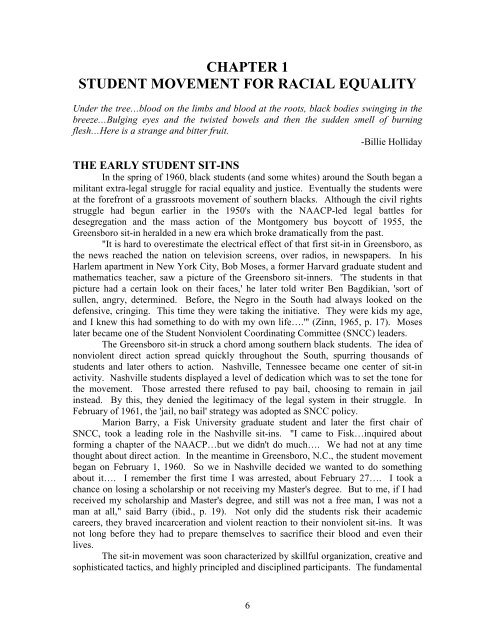
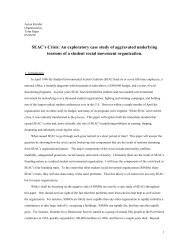
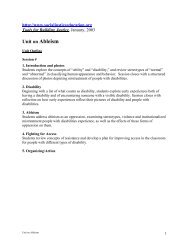

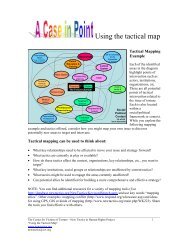
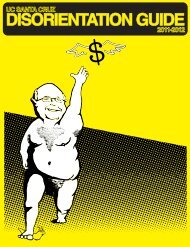

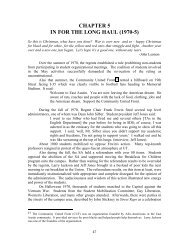
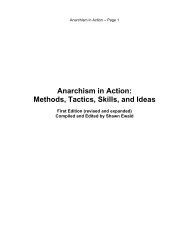

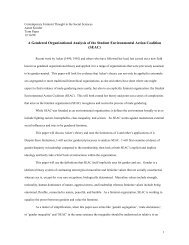

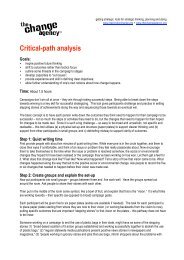

![Meaningful Student Involvement Research Guide [pdf] - SoundOut](https://img.yumpu.com/38822556/1/190x231/meaningful-student-involvement-research-guide-pdf-soundout.jpg?quality=85)